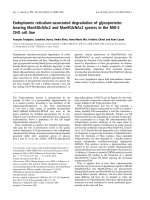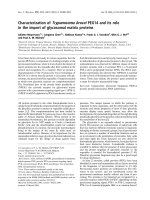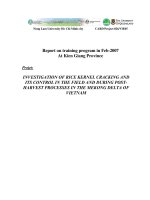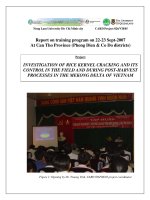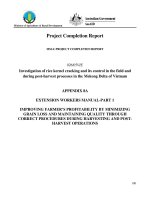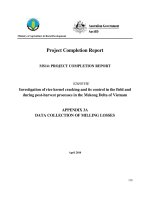OCEANOGRAPHIC PROCESSES OF CORAL REEFS: Physical and Biological Links in the Great Barrier Reef - Chapter 14 pptx
Bạn đang xem bản rút gọn của tài liệu. Xem và tải ngay bản đầy đủ của tài liệu tại đây (201.9 KB, 6 trang )
Steering by Coral Reef
Assemblages
Simon Spagnol, Eric Wolanski, and Eric Deleersnjider
CONTENTS
Introduction . . . . . . . . . . . . . . . . . . . . . . . . . . . . . . . . . . . . . . . . . . . . . . . . . . . . . . 231
Methods. . . . . . . . . . . . . . . . . . . . . . . . . . . . . . . . . . . . . . . . . . . . . . . . . . . . . . . . . 232
Results . . . . . . . . . . . . . . . . . . . . . . . . . . . . . . . . . . . . . . . . . . . . . . . . . . . . . . . . . . 233
Conclusion. . . . . . . . . . . . . . . . . . . . . . . . . . . . . . . . . . . . . . . . . . . . . . . . . . . . . . . 233
Acknowledgments. . . . . . . . . . . . . . . . . . . . . . . . . . . . . . . . . . . . . . . . . . . . . . . . . 234
References . . . . . . . . . . . . . . . . . . . . . . . . . . . . . . . . . . . . . . . . . . . . . . . . . . . . . . . 234
INTRODUCTION
The Great Barrier Reef (GBR) (Figure 1) is characterised by a juxtaposition of
regions of low reef density (where the reefs block only 10% of the length along the
shelf) and high reef density (where the reefs block about 90% of the length; Pickard
et al., 1977). Each of these regions is a few hundred kilometres in length. A large
spring-neap tide cycle exists on the GBR. Wolanski (1994) coined the term “sticky
water” to explain why regions of high reef density may be less permeable to low-
frequency currents at spring tides than at neap tides due to purely physical reasons.
Wolanski and Spagnol (2000) further investigated this effect numerically. They used
the two-dimensional model of King and Wolanski (1996) for a model barrier reef. In
this idealised bathymetry the reefs were assumed to be rectangular. Also, the prevail-
ing tidal and mean currents were parallel to each other. The prevailing currents were
oriented perpendicular to the longest sides of the rectangles. To illustrate the block-
ing effect, passive tracers were seeded upstream of the matrix of reefs. Only half as
much tracers filter through an ideal model reef matrix at spring tides than at neap
tides; the rest was deflected sideways. This deflection was due to energy dissipation
by bottom friction and island wakes. Further investigation into this effect for a real-
istic bathymetry and realistic currents could not be carried out due to lack of high res-
olution bathymetry data for the study region.
In this study, the work of Wolanski and Spagnol (2000) is extended to investigate
the currents flowing through and around a high reef density area in the central GBR.
In this area the spring and neap tide variability is pronounced, with the prevailing
tidal currents oriented perpendicular to the mean current (the East Australian
Current).
14
231
© 2001 by CRC Press LLC
METHODS
The field data were described by Wolanski and Spagnol (2000). In summary, the field
study was carried out along a cross-shelf transect on the outer shelf of the central
GBR (see Figure 1). The transect passes between Bowden Reef and Darnley Reef.
North of Bowden Reef, the reef density is low, i.e., the reefs block about 10% of the
distance along the shelf. South of Bowden Reef the reef density is high, i.e., the reefs
block about 90% of the length along the shelf. Offshore, in the adjoining Coral Sea,
the net flow is southward with the East Australian current (Wolanski, 1994). In this
area the tidal currents at the shelf break are mainly oriented cross-shelf.
Vector-averaging Aanderaa and InterOcean S4 current meters were deployed
along a cross-shelf transect at sites A to D (Figure 1) from January to March 1994.
Table 1 summarises the water depth and immersion depths of the meters. All current
meters and the tide gage recorded 30-min averaged currents. The water depth on the
shelf varies between 40 and 100 m. In this region only the crest of the reefs come out
of water at low spring tides.
CTD data were obtained at each mooring site at moorings’ deployment and
recovery.
Tidally predicted currents were calculated from field data using tidal harmonic
analysis. The tidally predicted currents include the mean current over the whole
period of observations. The residual currents were calculated as the difference
between the observed and tidally predicted currents. The wind-driven currents were
calculated as the linear fit between wind and residual currents.
The results from the field and the model were visualised using OpenDX, for-
merly known as Data Explorer (Galloway et al., 1995).
The depth-averaged two-dimensional model of King and Wolanski (1996) was
used to calculate the currents in this region including the tidal currents. The model
domain is shown in Figure 2; it was 169 km long and 119 km wide. The grid size was
500 m, the resolution at which bathymetric data were available. The forcing includes
the tides, the wind, and the East Australian Current, the latter being forced by pre-
scribing mean long-shelf and cross-shelf mean water slopes. These slopes were cal-
culated from a large-scale model of the circulation in the GBR (R. Brinkman,
unpublished data). The trajectories of water-borne tracers were predicted from these
232 Oceanographic Processes of Coral Reefs
TABLE 1
Current Meter Mooring Sites, January–March 1994
Site Water Depth (m) Elevation (m) of Current Meters
A 37 10 and 18
B 55 10 and 30
C65 20
D 114 38
E7 5
© 2001 by CRC Press LLC
data using the Lagrangian advection-diffusion model described by Oliver et al.
(1992) for which the eddy-diffusion coefficient was set to 3 m
2
s
Ϫ1
.
RESULTS
The CTD data show vertically well-mixed conditions in salinity and temperature.
Two days of current data are shown in Animations 1 and 2 for, respectively, neap
and spring tides. As noted also by Wolanski and Spagnol (2000), there was a net
southward current of about 0.15 to 0.2 m s
Ϫ1
at both inshore and offshore ends of the
region of high reef density (sites A and D). During that time calm weather prevailed
and the wind-driven currents were negligible. These two animations illustrate what
happens when in calm weather a net current meets a region of high reef density. At
neap tides (Animation 1) the currents at site B pointed for several hours toward the
passage between Old and Darnley Reef. Hence, the current was able to filter through
the reef matrix. However, at spring tides (Animation 2) the currents were deflected
offshore or inshore and largely flowed around, instead of through, the reef matrix.
The model was run for two tidal regimes, a neap tide of 2 m and a spring tide of
4 m (Animations 3 and 4, respectively). Clearly the model reproduced well the
spring-neap tide variability.
What is striking in these animations is the evidence of topographic steering of
both the tidal and mean currents. At neap tides, tidal and mean currents are of simi-
lar magnitude and the currents are able to filter through the reef passages. However,
at spring tides, the tidal currents are stronger than the mean currents and a boundary
layer effect develops. By this process the water entering the reef passage originates
from a tidal boundary layer along the upstream side of the reef. This layer is about
2 km wide. Outside of this layer the water is deflected around the reef. The reef
matrix thus becomes impermeable to the bulk of the water upstream; this water mov-
ing toward the reef assemblage with the East Australian Current is deflected sideways
at spring tides.
This blocking effect is made obvious by the evolution of a plume of passive trac-
ers released upstream from the area of high reef density. As shown in Animation 5 the
plume spreads and diffuses through the reef at neap tides. However, it is deflected
sideways around the reef matrix at spring tides (Animation 6). Thus the connectivity
of reefs for water-borne larvae (crown-of-thorns starfish, coral, and fish) is quite dif-
ferent at spring tide and at neap tides.
CONCLUSION
The variability of reef density and marked spring neap tidal cycle serves to introduce
spatial and temporal variability in the water circulation through the GBR that previ-
ous studies have neglected. This has profound implications for understanding the
connectivity between reefs and the degree of self-seeding of reefs. Studies of reef
recruitment of larvae have focused on individual reefs (see a literature review in
Carleton et al., Chapter 13, this book) and assumed either that larvae are available
Steering by Coral Reef Assemblages 233
© 2001 by CRC Press LLC
from upstream or that the currents around a reef can be studied independently from
other reefs. Previous reef connectivity studies (see a review in Wolanski & Spagnol,
2000) have not considered the blocking effect detailed in this chapter. All these
respective assumptions thus may be invalid in an area of high reef density at spring
tides; therefore the conclusions from these studies may also be invalid for high reef
density areas.
It is suggested that studies of reef recruitment and connectivity be initiated for
high reef density areas. This is important because these high reef density areas
occupy about half of the GBR.
ACKNOWLEDGMENTS
This research was supported by the Australian Institute of Marine Science. The bathy-
metric data were supplied by TESAG, James Cook University. Eric Deleersnijder is a
Research Associate with the National Fund for Scientific Research of Belgium.
REFERENCES
Galloway, D., Collins, P., Wolanski, E., King, B., & Doherty, P. 1995 Visualisation of oceano-
graphic and fisheries biology data for scientists and managers. IBM Communique 3, 1–3.
King, B. & Wolanski, E. 1996 Tidal current variability in the central Great Barrier Reef.
Journal of Marine Systems 9, 187–202.
Oliver, J., King, B., Willis, B., Babcock, R., & Wolanski, E. 1992 Dispersal of coral larvae from
a coral reef. Comparison between model predictions and observed concentrations.
Continental Shelf Research 12, 873–891.
Pickard, G.L., Donguy, J.R., Henin, C., & Rougerie, F. 1977 A Review of the Physical
Oceanography of the Great Barrier Reef and Western Coral Sea. Monograph Series Vol.
2, Australian Institute of Marine Science, Canberra, 134 pp.
Wolanski, E. 1994 Physical Oceanographic Processes of the Great Barrier Reef. CRC Press,
Boca Raton, FL, 194 pp.
Wolanski, E. & Spagnol, S. 2000 Sticky waters in the Great Barrier Reef. Estuarine, Coastal
and Shelf Science 50, 27–32.
234 Oceanographic Processes of Coral Reefs
© 2001 by CRC Press LLC
Steering by Coral Reef Assemblages 235
FIGURE 2 Bathymetry of the model domain of the
central region of the GBR. The area shown in Figure 1
is a subset of this figure.
ANIMATION 1 Three-dimensional visualisation of
the measured currents at the mooring sites during neap
tides and calm weather. The red arrows indicate the
tidally predicted currents and the blue arrows the
wind-driven currents (the latter are negligible). Local
time is indicated at the bottom. Australia is to the right
and the Coral Sea to the left. The view is vertically
distorted; mean depth around the reefs is 40 to 60 m,
and the width of the outer shelf where reefs are
scattered is about 50 km.
ANIMATION 2 Visualization of the measured
currents during spring tides and calm weather. The red
arrows indicate the tidally predicted currents and the
blue arrows the wind-driven currents (the latter are
negligible). Local time is indicated on the bottom.
Australia is to the right and the Coral Sea to the left.
The view is vertically distorted, mean depth around
the reefs is 40 to 60 m, and the width of the outer shelf
where reefs are scattered is about 50 km.
FIGURE 1 Three-dimensional view of the area
around Old Reef in the central region of the GBR.
This view also shows the mooring sites. The view is
from the north looking south. Australia is to the right
and the Coral Sea to the left. The view is vertically
distorted, mean depth around the reefs is 40 to 60 m,
and the width of the outer shelf where reefs are
scattered is about 50 km.
© 2001 by CRC Press LLC
236 Oceanographic Processes of Coral Reefs
ANIMATION 4 Visualisation of the plume of water-
borne tracers released upstream of Old Reef at neap
tides, no wind.
ANIMATION 5 Visualisation of the plume of water-
borne tracers released upstream of Old Reef at neap
tides, no wind.
ANIMATION 6 Visualisation of the plume of water-
borne tracers released upstream of Old Reef at spring
tides, no wind.
ANIMATION 3 Visualization of the predicted
currents near Old Reef at neap tides in calm weather,
during one tidal cycle.
© 2001 by CRC Press LLC
